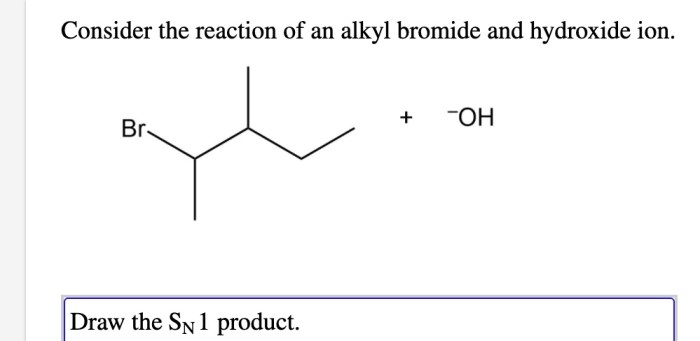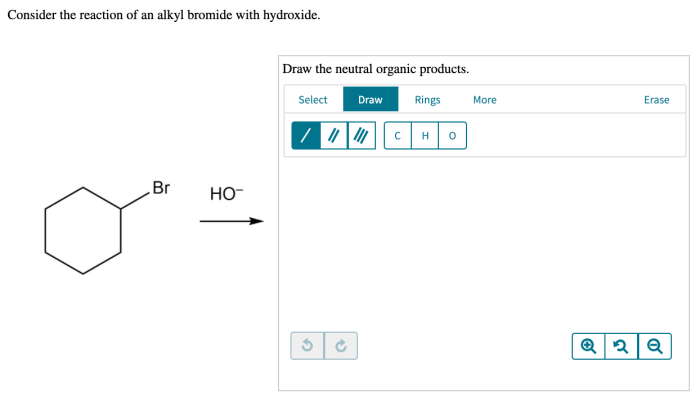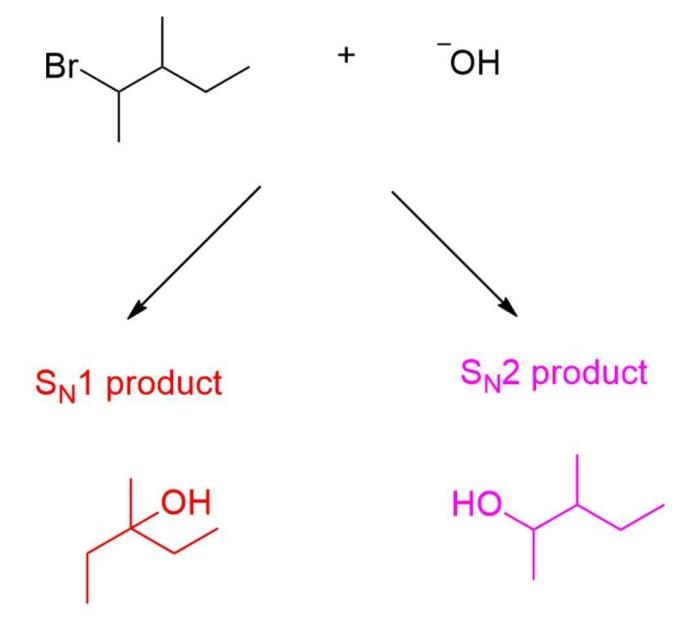Consider the reaction of an alkyl bromide and hydroxide ion, a fundamental transformation in organic chemistry that unveils the intricacies of nucleophilic substitution and regioselectivity. This reaction, widely employed in various industries, offers a gateway to understanding the mechanisms that govern the synthesis of complex organic molecules.
Delving into the depths of this reaction, we explore its applications in organic synthesis, unravel the factors influencing its regioselectivity, and elucidate the stereochemical outcomes that arise from this captivating transformation.
Reaction Overview
The reaction between an alkyl bromide and hydroxide ion is a fundamental organic reaction known as nucleophilic substitution. This reaction involves the replacement of the bromide ion with a hydroxide ion, resulting in the formation of an alcohol.
The general chemical equation for this reaction is:
R-Br + OH–→ R-OH + Br –
This reaction is classified as a nucleophilic substitution reaction, where the hydroxide ion acts as the nucleophile (electron-rich species) and attacks the electrophilic carbon atom of the alkyl bromide.
Nucleophilic Substitution: Consider The Reaction Of An Alkyl Bromide And Hydroxide Ion

Nucleophilic substitution is a reaction in which a nucleophile replaces a leaving group on an electrophile. In the case of the reaction between an alkyl bromide and hydroxide ion, the hydroxide ion is the nucleophile and the bromide ion is the leaving group.
The mechanism of this reaction proceeds through a two-step process:
- Nucleophilic attack: The hydroxide ion attacks the electrophilic carbon atom of the alkyl bromide, forming a tetrahedral intermediate.
- Leaving group departure: The bromide ion departs from the tetrahedral intermediate, resulting in the formation of the alcohol product.
The rate of nucleophilic substitution is affected by several factors, including the strength of the nucleophile, the electrophilicity of the alkyl bromide, and the solvent.
Regioselectivity

Regioselectivity refers to the preference for one reaction pathway over another, resulting in the formation of a specific regioisomer. In the reaction between an alkyl bromide and hydroxide ion, regioselectivity is determined by the stability of the carbocation intermediate formed during the reaction.
For example, the reaction of 2-bromobutane with hydroxide ion can produce two possible regioisomers: 1-butanol and 2-butanol. However, the reaction proceeds predominantly through the formation of the more stable tertiary carbocation intermediate, leading to the formation of 2-butanol as the major product.
Stereochemistry

The stereochemistry of the reaction products depends on the nature of the alkyl bromide and the reaction conditions. When an achiral alkyl bromide reacts with hydroxide ion, the reaction proceeds with inversion of configuration, resulting in the formation of an enantiomer of the starting material.
However, if the alkyl bromide is chiral, the reaction can proceed with either inversion or retention of configuration, depending on the reaction conditions. For example, the reaction of (R)-2-bromobutane with hydroxide ion can produce both (R)-2-butanol and (S)-2-butanol.
Applications
The reaction between an alkyl bromide and hydroxide ion is a versatile reaction that is widely used in organic synthesis. It is commonly employed for the preparation of alcohols, which are important intermediates in the synthesis of a variety of compounds, including pharmaceuticals, fragrances, and solvents.
Additionally, this reaction is used in the synthesis of ethers, esters, and other functionalized organic compounds. It is also used in the production of polymers, such as polyethylene and polypropylene.
Question Bank
What is the general reaction between an alkyl bromide and hydroxide ion?
The general reaction between an alkyl bromide and hydroxide ion is a nucleophilic substitution reaction, where the hydroxide ion acts as a nucleophile and attacks the electrophilic carbon atom of the alkyl bromide, resulting in the formation of an alcohol and bromide ion.
What is the mechanism of nucleophilic substitution in this reaction?
The mechanism of nucleophilic substitution in this reaction proceeds through a two-step process. In the first step, the hydroxide ion attacks the electrophilic carbon atom of the alkyl bromide, forming a tetrahedral intermediate. In the second step, the bromide ion is expelled, resulting in the formation of the alcohol product.
What factors affect the rate of nucleophilic substitution?
The rate of nucleophilic substitution is affected by several factors, including the nature of the nucleophile, the electrophilicity of the alkyl bromide, the solvent, and the temperature.
What is regioselectivity, and how does it apply to this reaction?
Regioselectivity refers to the preference for one regioisomer over another in a reaction. In the reaction of an alkyl bromide and hydroxide ion, regioselectivity is determined by the steric hindrance around the electrophilic carbon atom.
What are the stereochemical outcomes of this reaction?
The stereochemical outcomes of this reaction depend on the nature of the alkyl bromide and the reaction conditions. In some cases, the reaction can produce a mixture of enantiomers or diastereomers.